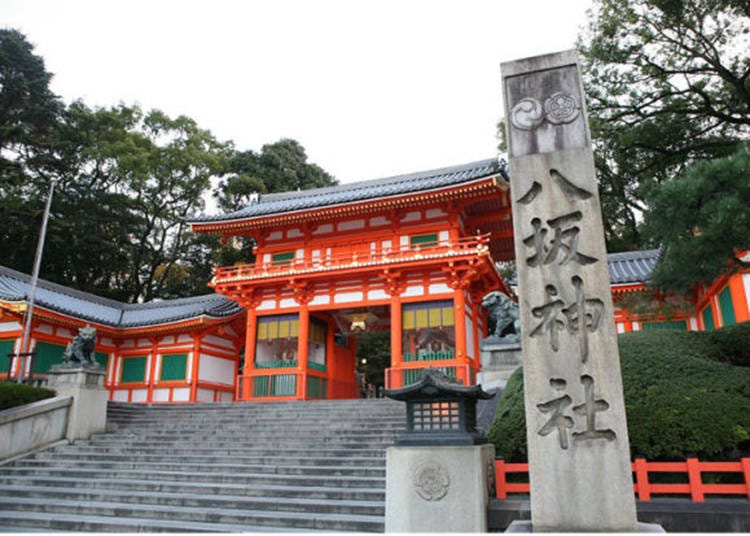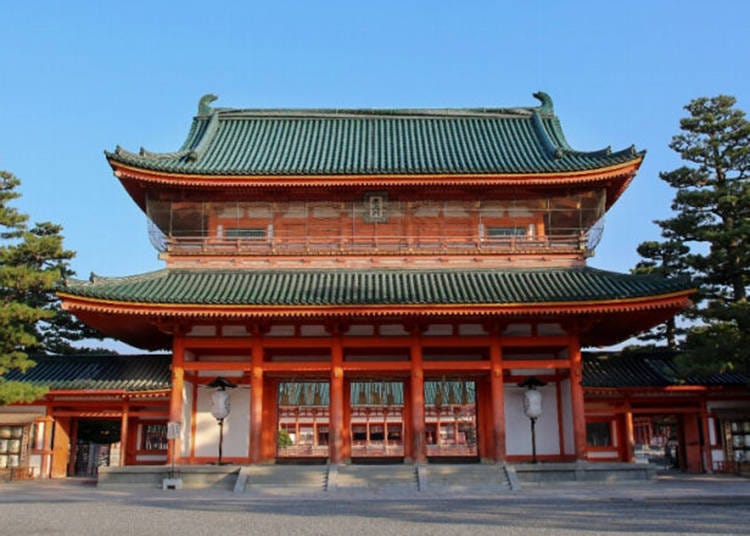Last updated: 26 December 2024
Japanese tend to visit a shrine or temple on New Year’s Day or New Year’s Eve to pray for the coming year, in a tradition called hatsumode. For visitors to Japan around this time, this is a fantastic experience to see and join in a fun New Year tradition!
With its historical shrines and temples filled with a serene atmosphere, hatsumode in Kyoto is a sensational experience in itself! Enjoy your own New Year’s visit at these 8 temples and shrines.
1. Kiyomizu-dera Temple (清水寺)

Now when you think of the quintessential Kyoto temple, Kiyomizu-dera might come to mind. It is also famous for being registered as one of the UNESCO World Cultural Heritage “Historic Monuments of Ancient Kyoto” sites in 1994.
Founded in 778 with a history of 1200 years, and a sacred site for the Kannon Bodhisattva, it isn’t just a tourist attraction – many people continue to worship here.
It is said that the 11 facial expressions and 42 hands of the gohonzon (the principal object of worship, such as Buddhist statues and images) – the 11-faced Kannon Bodhisattva – expresses great mercy and saves people from suffering. It is also said to materialize worldly wishes such as sound health, advancement in life, and good matches for relationships by praying to it.
Year-end and New Year Visiting Hours:
・January 1–7: 6 AM–6 PM
-

-
Address
1-294 Kiyomizu, Higashiyama-ku, Kyoto City, Kyoto Prefecture, 605-0862
View Map
-
Nearest Station
Gionshijo Station (Keihan Line)
25 minutes on foot
-
Phone Number
075-551-1234
-
Address
2. Kitano Tenmangu Shrine (北野天満宮)

Kitano Tenmangu is also called “Kitano no Tenjin-san” and the main shrine for Tenmangu and Tenjin Shrine. It was built in 947 to honor Sugawara no Michizane, the god of learning. It is said that there are about 12,000 shrines dedicated to Sugawara no Michizane all over Japan, and most of them originated from Kitano Tenmangu through divided spirits (Mitama / the virtue of the gods enshrined at the head office).
Terakoya, private temple schools, which were popular during the Edo period (1600-1867), displayed a portrait of Michizane. He became known as the god of performing arts and the god of academics due to many praying for academic and martial arts achievements. Many visitors come to worship during the New Year’s before the entrance exam season.
Many fans of Japanese history and katana visit the shrine, which is associated with Bunshin, the “god of war;” the Treasure Hall will hold an exhibition of swords and other artifacts for a limited time.
Year-end and New Year Visiting Hours:
・Daily, 7 AM–5 PM
-

-
Address
Bakurocho, Kamigyo-ku, Kyoto-shi, Kyoto, 602-8386
View Map
-
Nearest Station
Kitanohakubaicho Station (Keifuku Dentetsu-kitano Line)
5 minutes on foot
-
Phone Number
075-461-0005
-
Address
3. Yasaka Shrine (八坂神社)

Yasaka Shrine is also called “Gion-san.” The shrine has a long history and was called “Gion-sha” or “Kanshin-in” until it was renamed Yasaka Shrine in 1868. The Gion Matsuri festival held in the vicinity every July is a gorgeous and beautiful event that charms visitors.
The Utsukushi Gozen-sha located to the east of the main hall enshrines the beautiful and honorable Three Goddesses of Munakata, worshiped as the deities of “fortune,” “entertainment,” and “beauty.”
This year, on New Year’s Eve, you can’t wait for the New Year on the road or shrine grounds (concession stands are closed on shrine grounds). Also, the Minamiro-mon and Kita-mon will be closed, and the movement in the shrine will be in one direction. The only entrance is Nishiro-mon, and there are two exits on the east side of the main hall (Maruyama Park side).
Year-end and New Year Visiting Hours:
・Always open
*From 11 PM on December 31 to midnight on January 1, entry to the entire shrine grounds will be prohibited.
*Visitors already inside at that time will be required to exit following the staff’s instructions.
-

-
Address
625, Gionmachikitagawa, Higashiyama-ku, Kyoto-shi, Kyoto, 605-0073
View Map
-
Nearest Station
Gionshijo Station (Keihan Line)
5 minutes on foot
-
Phone Number
075-561-6155
-
Address
4. Heian-Jingu Shrine (平安神宮)

Heian-Jingu Shrine was built in 1895, commemorating the 1,100th anniversary of the founding of Heiankyo, the imperial capital of Japan. It is a symbol of reconstruction that eased the emotional blow caused by the shift of the capital from Kyoto to Tokyo during the Meiji Restoration and the urban area that was devastated by war at the end of the Edo period.
It enshrines Emperor Kanmu, the first emperor of the Heian period, and Emperor Komei, the last emperor of the Heian period. During the Jidai Matsuri, also one of Kyoto’s three major festivals, the spirits of Emperor Kanmu and Emperor Komei travel through Kyoto City.
Many worshipers visit Heian-Jingu Shrine for matchmaking, good luck, and warding off evil.
Every year from New Year’s Eve, the shrine conducts “Shuya Manto,” a ritual where all the lanterns on the shrine grounds are lit all night. They also welcome worshipers for New Year’s by increasing the number of conferment places that offer “Shinpu Mamorifuda” (lucky charms to place in household Shinto altars).
Year-end and New Year Visiting Hours:
・December 31 to January 1: All night–7 PM
・January 2–3: 6 AM–6:30 PM (Lucky charm, shuin services from 7 AM)
・January 4–5: 6 AM–5:30 PM (Lucky charm, shuin services from 7:30 AM)
・January 6: 6 AM–5 PM (Lucky charm, shuin services from 7:30 AM)
・Shin’en visitation: January 1–February 28, 8:30 AM – 4:30 PM
-

-
Address
97, Okazakinishitennoucho, Sakyo-ku, Kyoto-shi, Kyoto, 606-8341
View Map
-
Nearest Station
Higashiyama Station (Tozai Line)
10 minutes on foot
-
Phone Number
075-761-0221
-
Address
5. Shimogamo Shrine (下鴨神社)

Officially called Kamomioya Jinja, this shrine has a bit of a backstory to it. Kyoto’s city was planned around the Kamogawa River. This shrine, one of Kyoto’s oldest, is located downstream and now popularly known as Shimogamo (shimo = down, gamo = Kamogawa River). Records indicate that the shrine had repairs to its mizugaki (fence) in 90 BC. In 1994, the shrine grounds, including the Tadasu-no-Mori forest, were registered as a World Heritage Site.
Aioi Shrine is located in Tadasu no Mori, and it is dedicated to matchmaking. It has attracted worshipers from ancient times for its wonder-working. Here you’ll find “Renri-no-Sakaki,” a tree considered sacred for marriage because it comprises two trees intertwined into a single tree; it is also considered one of Kyoto’s seven wonders. Tradition has it that when the sacred tree withers, it is reborn somewhere in the Tadasu-no-Mori forest. The current tree is the 4th generation.
Year-end and New Year Visiting Hours:
・December 31: 6:30 AM–6 PM
・January 1: Midnight–5 PM
・January 2–3: 6 AM–6 PM
・From January 4: 6 AM–5 PM
-

-
Address
59, Shimogamoizumigawacho, Sakyo-ku, Kyoto-shi, Kyoto, 606-0807
View Map
-
Nearest Station
Demachiyanagi Station (Eizan Dentetsu Eizan Line)
10 minutes on foot
-
Phone Number
075-781-0010
-
Address
6. Kifune Shrine (貴船神社)

Kifune Shrine, located in Kifune, is the head of over 2,000 shrines that enshrine the god of water, and there are records of rebuilding the shrine dating back to 677. Worshiping at Kifune Shrine is called Sanshamode, including worshiping at the main shrine, Yui-no-Yashiro, and the rear shrine.
The main shrine was moved to its current location in 1055 when the back hall was swept away in a flood. The back hall is the founding place of the Kifune Shrine and remains a sacred place. Yui-no-Yashiro is between the two and is famous for matchmaking.
During the Heian Period, the female poet Izumi Shikibu visited the shrine due to worries about her husband’s change of heart; her wishes were fulfilled, and since then, the shrine has been called the Koi-no-Miya (Shrine of Love). Worshipers continue to visit to pray for fortune and prosperity, matchmaking, and wish fulfillment.
Year-end and New Year Visiting Hours:
・December 31: 6 AM–6 PM (Closes between 6 PM to 8 PM, reopens 10 PM)
・December 31: 10 PM–January 1, 8 PM
・January 2-3: 6 AM–8 PM
・From January 4: 6 AM–6 PM
-

-
Address
180, Kuramakibunecho, Sakyo-ku, Kyoto-shi, Kyoto, 601-1112
View Map
-
Nearest Station
Kibuneguchi Station (Eizan Dentetsu-kurama Line)
30 minutes on foot
-
Phone Number
075-741-2016
-
Address
7. Kamigamo Shrine (上賀茂神社)

Kamo-Wakeikazuchi Shrine, known as Kamigamo Shrine, is also an old shrine where the foundation built in 678 remains almost unchanged. It was registered as a World Heritage Site in 1994.
Through the divine power of lightning, worshipers pray for protection such as warding off evil, protection from lightning strikes, and is worshiped as the guardian of electricity.
From January 1 to 3rd, they hold an event called “Yaku yoke daikon,” in which they prepare daikon radish in a large pot praying for sound health, and offer it to worshipers. During the first three days of the New Year, there is a shuttle bus to Kamigamo Shrine every 10 minutes from Kyoto City Subway Karasuma Line Kitayama Station Exit 4 (100 yen per person one way).
Year-end and New Year Visiting Hours: (Sakura-mon)
・December 31: 8 AM–5 PM
・January 1: Midnight–5:30 PM
・January 2–5: 7 AM–4:30 PM
・From January 6: 8 AM–4:45 PM
-

-
Address
339, Kamigamomotoyama, Kita-ku, Kyoto-shi, Kyoto, 603-8047
View Map
-
Nearest Station
Kitaoji Station (Karasuma Line)
10 minutes by bus
-
Phone Number
075-781-0011
-
Address
8. Matsunoo Taisha Shrine (松尾大社)

Matsunoo Taisha was built in 701 by Hata no Imikitori, but it is said that the residents enshrined the deity Ooyamakui-no-Kami in Matsunoo Mountain (behind the main hall) in ancient times. It is said to be the oldest shrine in Kyoto, and it is even noted in the Kojiki, the oldest history book in Japan.
Matsunoo Taisha is also famous for enshrining the god of sake brewing. There is a saying that using the holy water from Kame-no-I well will prevent the sake from going bad when brewing it. Since the shrine offers a blessing for sake brewing, it has many worshipers from that industry. The water from the well Kame-no-I is worshiped for its blessings of longevity and resurrection.
Year-end and New Year Visiting Hours: (opening hours)
・December 31: 5 AM– 7 PM on January 1
・From January 2: 5 AM–6 PM
-

-
Address
3, Arashiyamamiyamachi, Nishikyo-ku, Kyoto-shi, Kyoto, 616-0024
View Map
-
Nearest Station
Matsuotaisha Station (Hankyu Arashiyama Line)
3 minutes on foot
-
Phone Number
075-871-5016
-
Address
Normally, hatsumode is held up to January 7 (known as ‘Matsu-no-Uchi’ – the day until when New Year’s decorations are kept up).
In Kyoto, there are countless attractive shrines and temples other than the 9 we have introduced. We recommend looking up the blessings and history of these locations and taking your time to visit.
* Depending on the situation visiting hours and events may be changed, delayed or cancelled. Please check with their official website before visiting.
(This article was originally published in December 2020 and updated in December 2024.)
Written by:

Kiko Matsuda, Keiko Kimura, Risa Tsushi, and a team of female writers familiar with Kansai. We love eating, drinking and traveling! We share fun information based on our experiences.
*This information is from the time of this article’s publication.
*Prices and options mentioned are subject to change.
*Unless stated otherwise, all prices include tax.























Discussion about this post